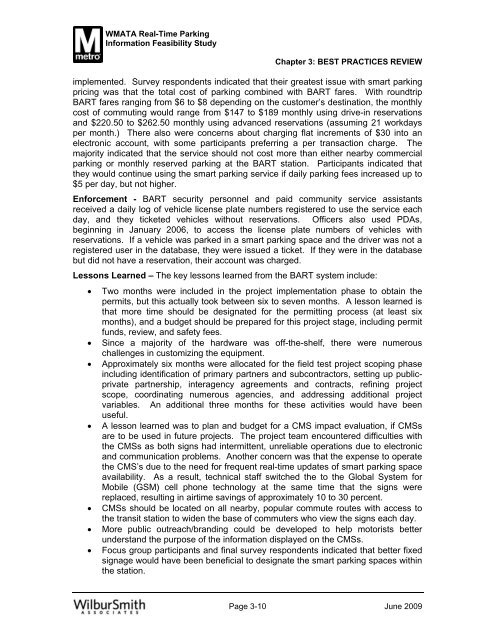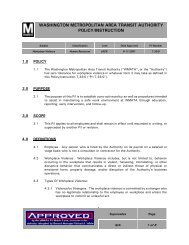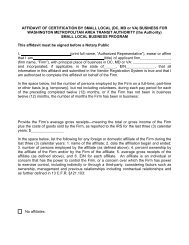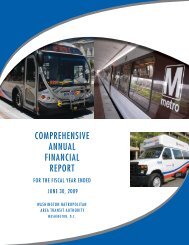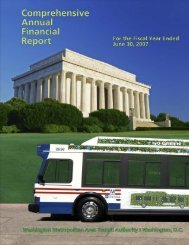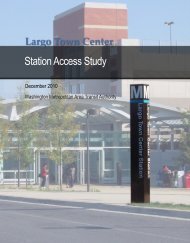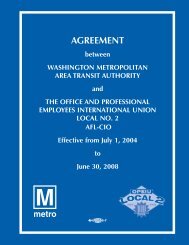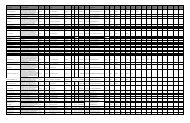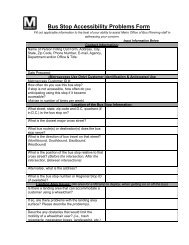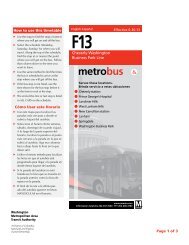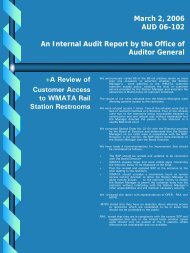feasibility study of real time parking information at ... - WMATA.com
feasibility study of real time parking information at ... - WMATA.com
feasibility study of real time parking information at ... - WMATA.com
You also want an ePaper? Increase the reach of your titles
YUMPU automatically turns print PDFs into web optimized ePapers that Google loves.
<strong>WMATA</strong> Real-Time Parking<br />
Inform<strong>at</strong>ion Feasibility Study<br />
Chapter 3: BEST PRACTICES REVIEW<br />
implemented. Survey respondents indic<strong>at</strong>ed th<strong>at</strong> their gre<strong>at</strong>est issue with smart <strong>parking</strong><br />
pricing was th<strong>at</strong> the total cost <strong>of</strong> <strong>parking</strong> <strong>com</strong>bined with BART fares. With roundtrip<br />
BART fares ranging from $6 to $8 depending on the customer’s destin<strong>at</strong>ion, the monthly<br />
cost <strong>of</strong> <strong>com</strong>muting would range from $147 to $189 monthly using drive-in reserv<strong>at</strong>ions<br />
and $220.50 to $262.50 monthly using advanced reserv<strong>at</strong>ions (assuming 21 workdays<br />
per month.) There also were concerns about charging fl<strong>at</strong> increments <strong>of</strong> $30 into an<br />
electronic account, with some participants preferring a per transaction charge. The<br />
majority indic<strong>at</strong>ed th<strong>at</strong> the service should not cost more than either nearby <strong>com</strong>mercial<br />
<strong>parking</strong> or monthly reserved <strong>parking</strong> <strong>at</strong> the BART st<strong>at</strong>ion. Participants indic<strong>at</strong>ed th<strong>at</strong><br />
they would continue using the smart <strong>parking</strong> service if daily <strong>parking</strong> fees increased up to<br />
$5 per day, but not higher.<br />
Enforcement - BART security personnel and paid <strong>com</strong>munity service assistants<br />
received a daily log <strong>of</strong> vehicle license pl<strong>at</strong>e numbers registered to use the service each<br />
day, and they ticketed vehicles without reserv<strong>at</strong>ions. Officers also used PDAs,<br />
beginning in January 2006, to access the license pl<strong>at</strong>e numbers <strong>of</strong> vehicles with<br />
reserv<strong>at</strong>ions. If a vehicle was parked in a smart <strong>parking</strong> space and the driver was not a<br />
registered user in the d<strong>at</strong>abase, they were issued a ticket. If they were in the d<strong>at</strong>abase<br />
but did not have a reserv<strong>at</strong>ion, their account was charged.<br />
Lessons Learned – The key lessons learned from the BART system include:<br />
• Two months were included in the project implement<strong>at</strong>ion phase to obtain the<br />
permits, but this actually took between six to seven months. A lesson learned is<br />
th<strong>at</strong> more <strong>time</strong> should be design<strong>at</strong>ed for the permitting process (<strong>at</strong> least six<br />
months), and a budget should be prepared for this project stage, including permit<br />
funds, review, and safety fees.<br />
• Since a majority <strong>of</strong> the hardware was <strong>of</strong>f-the-shelf, there were numerous<br />
challenges in customizing the equipment.<br />
• Approxim<strong>at</strong>ely six months were alloc<strong>at</strong>ed for the field test project scoping phase<br />
including identific<strong>at</strong>ion <strong>of</strong> primary partners and subcontractors, setting up publicpriv<strong>at</strong>e<br />
partnership, interagency agreements and contracts, refining project<br />
scope, coordin<strong>at</strong>ing numerous agencies, and addressing additional project<br />
variables. An additional three months for these activities would have been<br />
useful.<br />
• A lesson learned was to plan and budget for a CMS impact evalu<strong>at</strong>ion, if CMSs<br />
are to be used in future projects. The project team encountered difficulties with<br />
the CMSs as both signs had intermittent, unreliable oper<strong>at</strong>ions due to electronic<br />
and <strong>com</strong>munic<strong>at</strong>ion problems. Another concern was th<strong>at</strong> the expense to oper<strong>at</strong>e<br />
the CMS’s due to the need for frequent <strong>real</strong>-<strong>time</strong> upd<strong>at</strong>es <strong>of</strong> smart <strong>parking</strong> space<br />
availability. As a result, technical staff switched the to the Global System for<br />
Mobile (GSM) cell phone technology <strong>at</strong> the same <strong>time</strong> th<strong>at</strong> the signs were<br />
replaced, resulting in air<strong>time</strong> savings <strong>of</strong> approxim<strong>at</strong>ely 10 to 30 percent.<br />
• CMSs should be loc<strong>at</strong>ed on all nearby, popular <strong>com</strong>mute routes with access to<br />
the transit st<strong>at</strong>ion to widen the base <strong>of</strong> <strong>com</strong>muters who view the signs each day.<br />
• More public outreach/branding could be developed to help motorists better<br />
understand the purpose <strong>of</strong> the <strong>inform<strong>at</strong>ion</strong> displayed on the CMSs.<br />
• Focus group participants and final survey respondents indic<strong>at</strong>ed th<strong>at</strong> better fixed<br />
signage would have been beneficial to design<strong>at</strong>e the smart <strong>parking</strong> spaces within<br />
the st<strong>at</strong>ion.<br />
Page 3-10 June 2009


